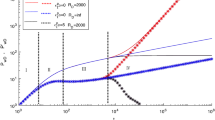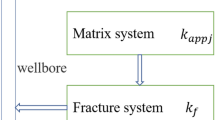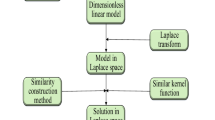Abstract
In oil and gas engineering, non-Newtonian fluids are universal. Thus, studies on the seepage laws of non-Newtonian power-law fluids are of great importance and significance. In this paper, we introduced the definition of elastic coefficient based on the establishing elastic outer boundary conditions. We then set up a homogeneous well test model for non-Newtonian power-law fluids under elastic outer boundary conditions, considering wellbore reservoir and skin effect. The Laplace space solution of the bottom hole pressure was obtained using the similar structure method, and the double logarithmic characteristic curve was drawn using the Stehfest numerical inversion technique. Furthermore, the main parameters affecting the characteristic curve were analyzed. The experimental results showed that the early phase of the homogeneous well test curve can be affected by the wellbore storage coefficient. In addition, the mid-term seepage is greatly influenced by the power-law flow exponent and the skin factor, while the elastic coefficient predominantly acts on the later phase of fluid flow. We concluded that the introduction of the elastic outer boundary expands the traditional fixed form of ideal outer boundary conditions, enabling a more general representation of the seepage model. This approach provides a more effective theoretical basis for further exploration of the seepage law of the reservoir. Meanwhile, we simplify the calculation process of the solution model by the use of the similar structure method of the solution and point out a new research direction for solving the more complex seepage model.









Similar content being viewed by others
References
Ikoku, C.U., Ramey, H.J.: Transient flow of non-Newtonian power-law fluids in porous media. Soc. Petrol. Eng. J. 19(03), 164–174 (1979). https://doi.org/10.2118/7139-pa
Vongvuthipornchai, S., Raghavan, R.: Well test analysis of data dominated by storage and skin: non-Newtonian power-law fluids. SPE Form. Eval. 2(04), 618–628 (1987). https://doi.org/10.2118/14454-pa
Yang, Y.: Characteristic curves for spherical flow of non-Newtonian power-law fluid. J. Oil Gas Technol. 30(06), 146–148389 (2008)
Wang, Y., Wang, X., Shi, Z., Zhang, Y.: Pressure drawdown analysis for the non-Newtonian power-law fluid in bounded reservoirs. Chin. J. Hydrodyn. 24(01), 36–42 (2009)
Su, J.: The behaviors of non-Newtonian power-law fluids flow through homogeneous reservoir. MA thesis, Xihua University (2010)
Li, S., Zhao, C., Zheng, P., Gui, Q.: Analysis of oil and gas flow characteristics in the reservoir with the elastic outer boundary. J. Petrol. Sci. Eng. 175, 280–285 (2019). https://doi.org/10.1016/j.petrol.2018.12.042
Woods, J.H., Sauro, H.M.: Elasticities in metabolic control analysis: algebraic derivation of simplified expressions. Comput. Appl. Biosci. 13(2), 123–30 (1997). https://doi.org/10.1093/bioinformatics/13.2.123
Li, S., Zhou, M., Zheng, P., Dong, X., Gui, Q.: Analysis of seepage pressure in dual-porosity reservoir under elastic boundary. J. Math. Comput. Sci. (2020). https://doi.org/10.28919/jmcs/4376
Li, S., Guo, H., Zheng, P., Dong, X., Zhao, C., Gui, Q.: The elastic boundary value problem of extended modified Bessel equation and its application in fractal homogeneous reservoir. Comput. Appl. Math. (2020). https://doi.org/10.1007/s40314-020-1104-1
Zheng, P., Zheng, Y., Li, S., Leng, L., Xia, X.: Analysis of flow characteristics of the dual media shale gas reservoir with the elastic outer boundary. SN Appl. Sci. (2021). https://doi.org/10.1007/s42452-021-04787-y
Van Poollen, H.K., Jargon, J.R.: Steady-state and unsteady-state flow of non Newtonian fluids through porous media. Soc. Petrol. Eng. J. 9(01), 80–88 (1969). https://doi.org/10.2118/1567-pa
Odeh, A.S., Yang, H.T.: Flow of non-Newtonian power-law fluids through porous media. Soc. Petrol. Eng. J. 19(03), 155–163 (1979). https://doi.org/10.2118/7150-pa
Xu, J.: Pressure solutions for unsteady test wells with non-Newtonian power-law fluids. Test Min. Technol. 1(14), 4–825 (1993)
Li, J., Wang, X.: Nonlinear solution to pressure characteristics of non-Newtonian power law fluid. Well Test. 19, 237576 (1998)
Li, Y., Cai, R.: A concise analytical solutions of well test analysis: non-Newtonian power-law fluids. Sci. Technol. Rev. 28(18), 32–35 (2010)
Adomian, G.: A review of the decomposition method and some recent results for nonlinear equations. Math. Comput. Model. 13, 17–43 (1990)
Bougoffa, L., Rach, R.C.: Solving nonlocal boundary value problems for first- and second-order differential equations by the adomian decomposition method. Kybernetes 42(4), 641–664 (2013). https://doi.org/10.1108/k-09-2012-0045
Fatoorehchi, H., Abolghasemi, H.: Approximating the minimum reflux ratio of multicomponent distillation columns based on the adomian decomposition method. J. Taiwan Inst. Chem. Eng. 45(3), 880–886 (2014). https://doi.org/10.1016/j.jtice.2013.09.032
Fatoorehchi, H., Abolghasemi, H.: Series solution of nonlinear differential equations by a novel extension of the Laplace transform method. Int. J. Comput. Math. 93(8), 1299–1319 (2016). https://doi.org/10.1080/00207160.2015.1045421
Fatoorehchi, H., Alidadi, M.: The extended Laplace transform method for mathematical analysis of the Thomas-Fermi equation. Chin. J. Phys. 55(6), 2548–2558 (2017). https://doi.org/10.1016/j.cjph.2017.10.001
Albattat, R., Hoteit, H.: A semi-analytical approach to model drilling fluid leakage into fractured formation. Rheol. Acta 60(6–7), 353–370 (2021). https://doi.org/10.1007/s00397-021-01275-3
Li, S.: The similar structure of solution of the second-order linear homogeneous differential equation with constant coefficients on the boundary value problem. J. Xihua Univ (Natural Science Edition) 84, 85104 (2007)
Li, S., Zheng, P., Zhang, Y.: Similar structure of pressure distribution in the multilayer reservoir. Appl. Math. J. Chin. Univ. (Ser A) 24(02), 234–238 (2009)
Li, S., Wang, J., Xu, L.: The similar structure of solutions to the spherical fluids flow problems for a composite reservoir. Math. Pract. Theory 44(03), 122–127 (2014)
Li, S., Ren, L., Zheng, P., Gui, Q.: Similar structure of the solution to the dual-porosity model for naturally fractured shale gas reservoirs based on stress sensitivity. Appl. Math. Mech. 38(02), 233–242 (2017)
Stehfest, H.: Numerical inversion of Laplace transforms. Commun. ACM 13, 47–49
Kong, X.Y., Xu, X.Z., Lu, D.T.: Pressure transient analysis for horizontal well and multi-branched horizontal wells. In: International Conference on Horizontal Well Technology (1996). https://doi.org/10.2118/37069-ms
Igbokoyi, A.O., Tiab, D.: New type curves for the analysis of pressure transient data dominated by skin and wellbore storage-non-Newtonian fluid. Paper Presented at the Production and Operations Symposium, Oklahoma City, Oklahoma, USA (2007). https://doi.org/10.2118/106997-MS
Omosebi, O.A., Akabogu., A.K.: Application of the Galerkin’s finite element method to the flow of power-law non-Newtonian fluids through porous media. Paper Presented at the SPE Western Regional Meeting, Bakersfield, California (2017). https://doi.org/10.2118/185689-MS
Fatoorehchi, H.: An accurate numerical method for inversion of Laplace transforms with applications in process dynamics and control. Can. J. Chem. Eng. 99(6), 1374–1389 (2020). https://doi.org/10.1002/cjce.23926
Liao, Z., Li, S.: A new method for solving the boundary value problem of extend Bessel equation: the similar structuring method. J. Univ. Sci. Technol. China 43(12), 975–979 (2013)
Marshall, A.: Principles of Economics. Macmillan and Co., New York (1920)
Lazar, M., Maugin, G.A., Aifantis, E.C.: On dislocations in a special class of generalized elasticity. Phys. Status Solidi (B) 242(12), 2365–2390 (2005). https://doi.org/10.1002/pssb.200540078
Sato, H., Kataoka, N., Kajiya, F., Katano, M., Takigawa, T., Masuda, T.: Kinetic study on the elastic change of vascular endothelial cells on collagen matrices by atomic force microscopy. Colloids Surf. B 34(2), 141–146 (2004). https://doi.org/10.1016/j.colsurfb.2003.12.013
Berko, N.S., Fitzgerald, E.F., Amaral, T.D., Payares, M., Levin, T.L.: Ultrasound elastography in children: establishing the normal range of muscle elasticity. Pediatr. Radiol. 44(2), 158–163 (2014). https://doi.org/10.1007/s00247-013-2793-z
Funding
Funding was provided by Study on the percolation characteristics of Shale Gas Reservoirs (Grant No. 2015JY0245), Xihua University graduate curriculum construction project (Grant No. YJSKC20204).
Author information
Authors and Affiliations
Corresponding author
Ethics declarations
Conflict of interest
The authors declare no competing interests.
Additional information
Publisher's Note
Springer Nature remains neutral with regard to jurisdictional claims in published maps and institutional affiliations.
Appendices
Appendix A: The process of solving the boundary value problem
For the boundary value problem of the second-order linear homogeneous ordinary differential equation
where A, B, D, E, F, a, b, d are all real constants, and \(D \ne 0\), \(0< a < b\).
Assuming that there exists a unique solution to the boundary value problem Eq. (A1), the solution can be described in the following continuous fractional form
Derivation: the definite solution equation in the boundary value problem Eq. (A1) is made variable replacement
then it is reduced to the following modified Bessel equation that can be shown as follows
where \(m = \frac{{A - 1}}{2}\), \(l = \frac{d}{2}\), \(\kappa \mathrm{{ = }}\frac{{2\sqrt{B} }}{d}\), \(v = \frac{{1 - A}}{d}\).
Then, the general solution of the modified Bessel equation Eq. (A4) is
where \({C_1}\), \({C_2}\) are arbitrary constants and \({I_v}\left( \cdot \right) \), \({K_v}\left( \cdot \right) \) are the first and second type of modified Bessel functions of order v, respectively. Bringing Eq. (A5) into the variable substitution Eq. (A3), the general solution of the definite solution equation in the boundary value problem Eq. (A1) can be shown as:
Bringing Eq. (A6) into the second and third equations in the boundary value problem Eq. (A1), we obtain
Combining Eqs. (4)–(8), we obtain the coefficient matrices of Eqs. (A7) and (A8)
Because \(\Delta \ne 0\) and \(D \ne 0\), so applying Cramer’s rule, we can find \({C_1}\), \({C_2}\),
Bring Eqs. (A10) and (A11) into Eq. (A6) and collate to get
Define the similar kernel function \(\Phi \left( x \right) \) as Eq. (3), then Eq. (A12) can be reduced to Eq. (2).
Appendix B Nomenclature
Subscript:
D = Dimensionless
w = Well
Symbol | Meaning | Unit |
|---|---|---|
p | Pressure | MPa |
\({p_0}\) | Initial pressure | MPa |
\({p_w}\) | Wellbore pressure | MPa |
r | Radial distance | m |
\({r_w}\) | Wellbore distance | m |
\({\mu _{eff}}\) | Effective viscosity for power-law fluids | Mpa s |
\({\mu ^ * }\) | Characteristic viscosity for power-law fluids | Mpa s |
q | Flow rate, stock-tank | \(\mathrm{m^3}/\textrm{d}\) |
\({q_{sf}}\) | Sand-face flow rate, stock-tank | \(\mathrm{m^3}/\textrm{d}\) |
k | Permeability | \(\mu \mathrm{m^2}\) |
\({C_t}\) | Total compressibility | \(\textrm{MP}\mathrm{a^{ - 1}}\) |
\({C_L}\) | Fluid compressibility | \(\textrm{MP}\mathrm{a^{ - 1}}\) |
\({C_f}\) | Rock compressibility | \(\textrm{MP}\mathrm{a^{ - 1}}\) |
C | Wellbore storage coefficient | \(\mathrm{m^3}/\textrm{MPa}\) |
h | Reservoir thichness | m |
t | Production time | h |
n | Flow behavior index(power law paeameter) | Dimensionless |
\({\varepsilon _r}\) | Elastic coefficient | Dimensionless |
\(\phi \) | Porosity | Dimensionless |
S | Skin factor | Dimensionless |
Rights and permissions
Springer Nature or its licensor (e.g. a society or other partner) holds exclusive rights to this article under a publishing agreement with the author(s) or other rightsholder(s); author self-archiving of the accepted manuscript version of this article is solely governed by the terms of such publishing agreement and applicable law.
About this article
Cite this article
Sun, Cy., Zheng, Ps., Qian, X. et al. Similar construction method for non-Newtonian power-law fluid seepage models with elastic outer boundary conditions. Arch Appl Mech 93, 3609–3624 (2023). https://doi.org/10.1007/s00419-023-02456-7
Received:
Accepted:
Published:
Issue Date:
DOI: https://doi.org/10.1007/s00419-023-02456-7




